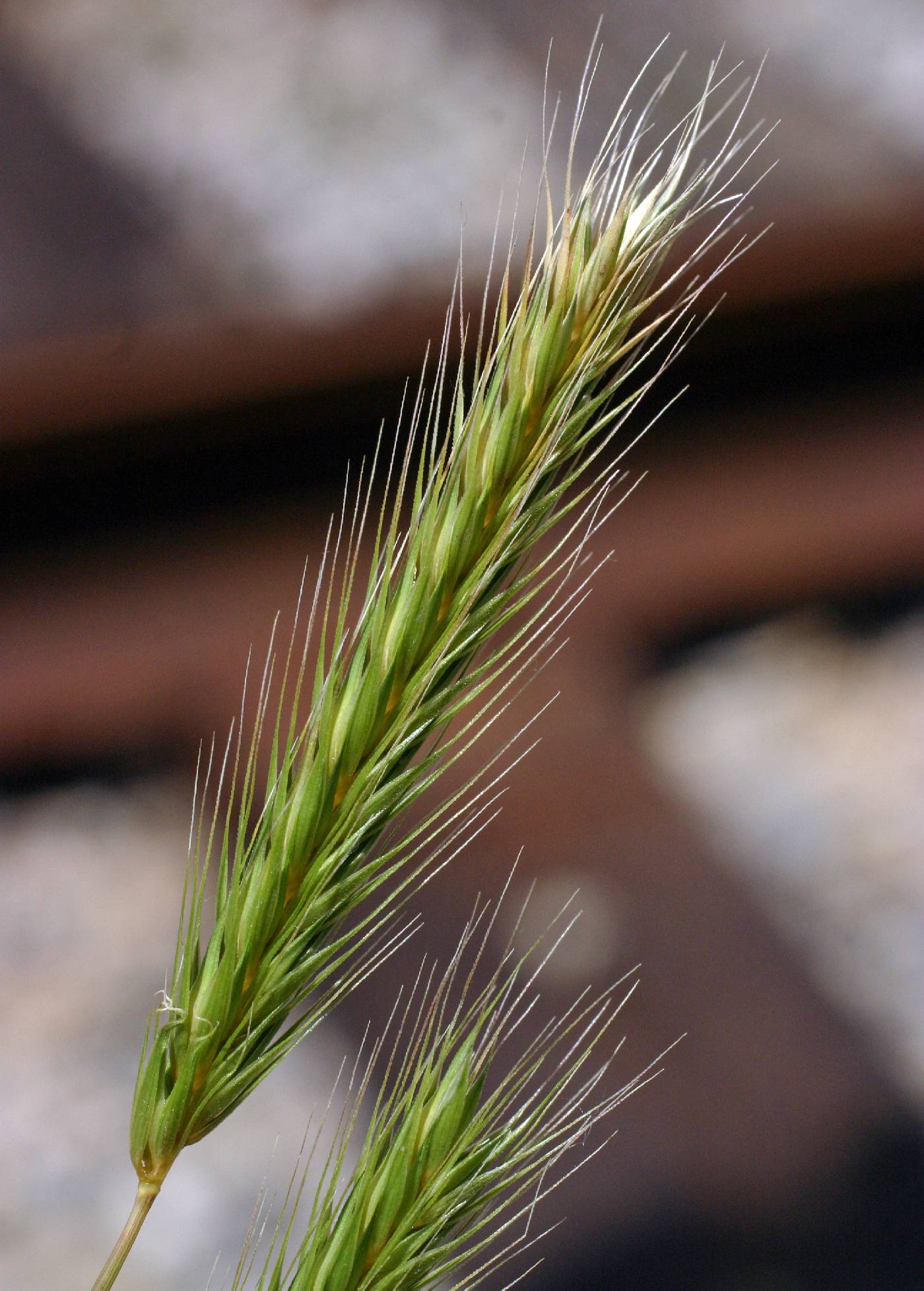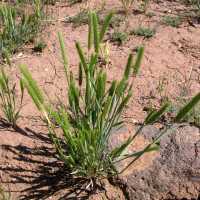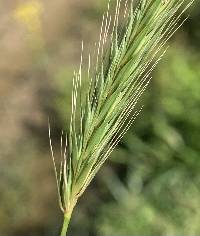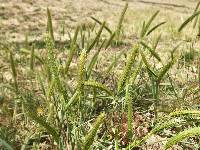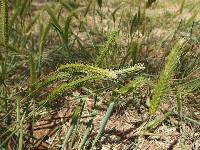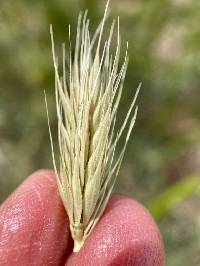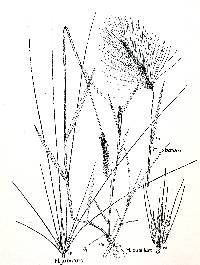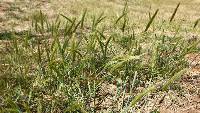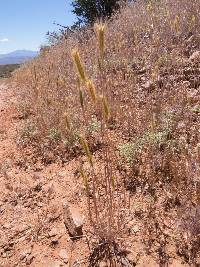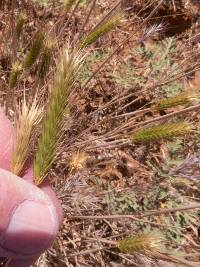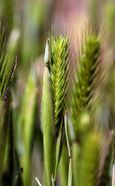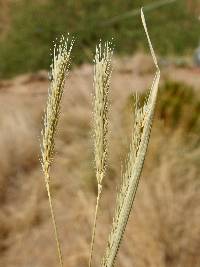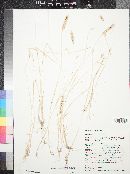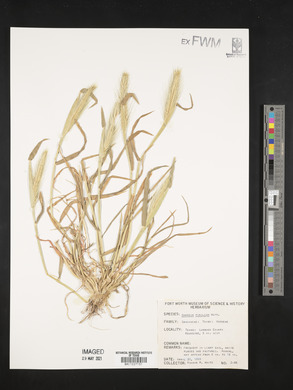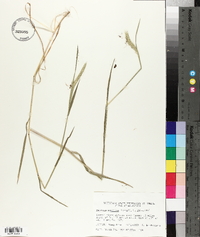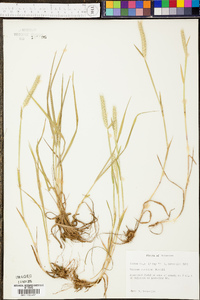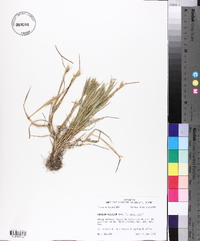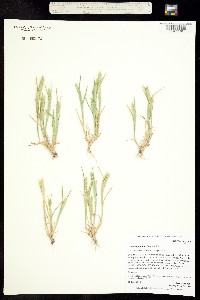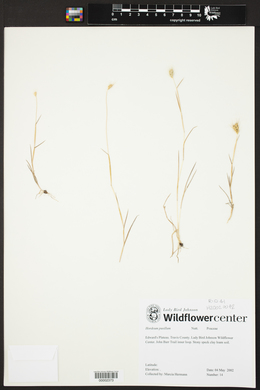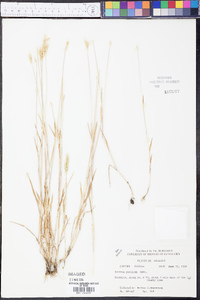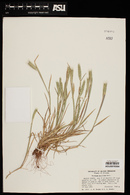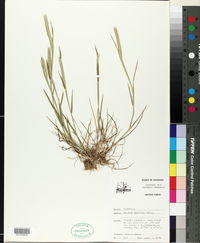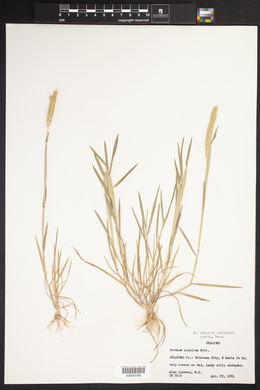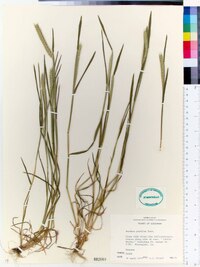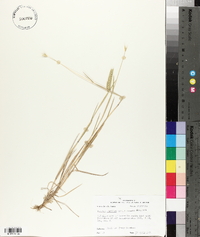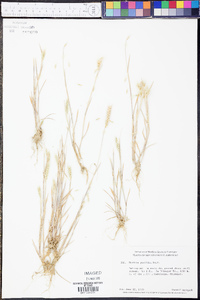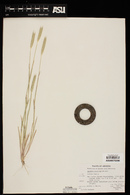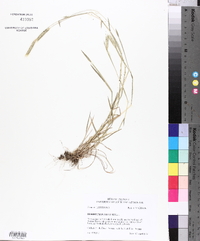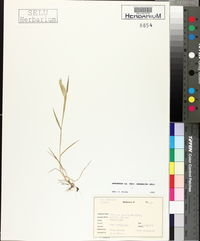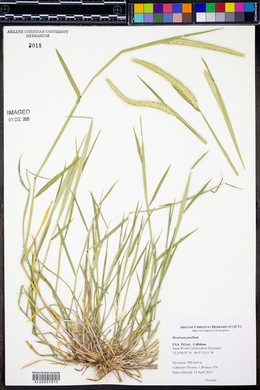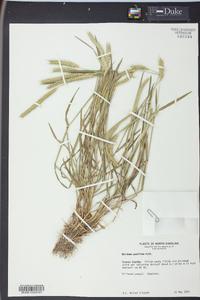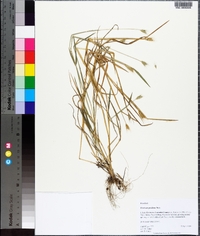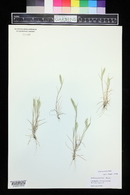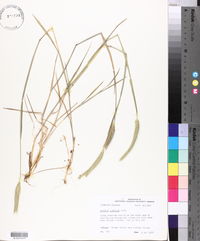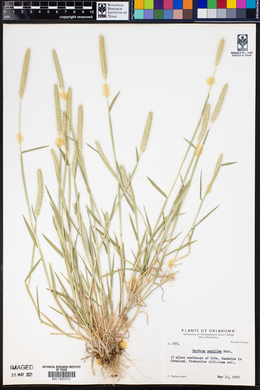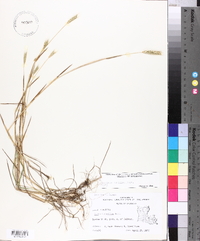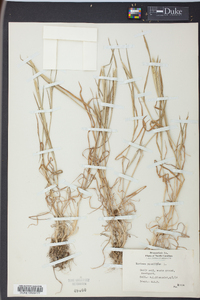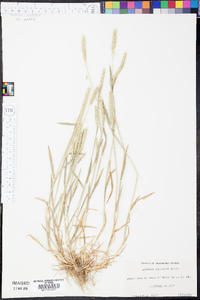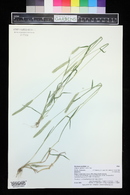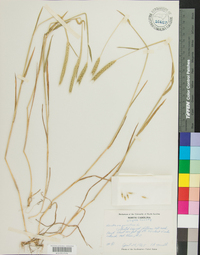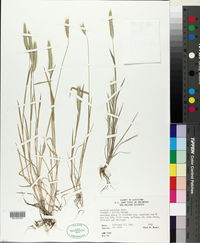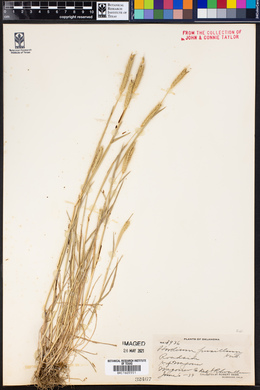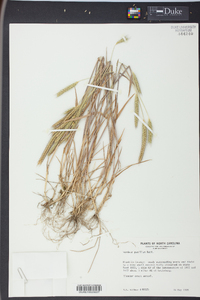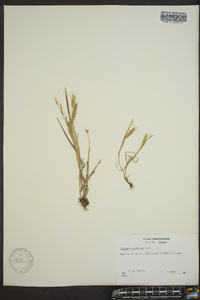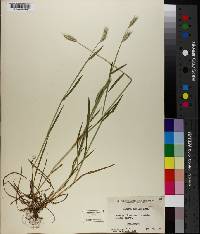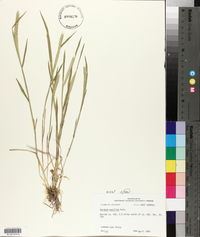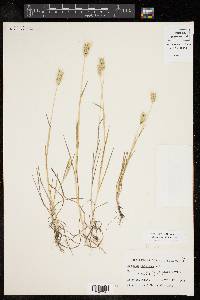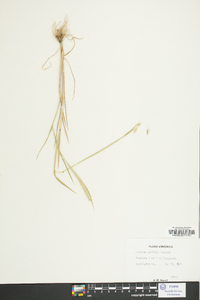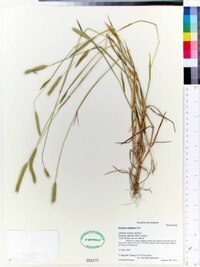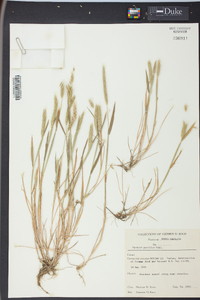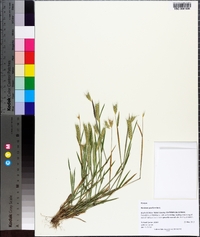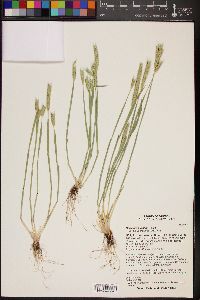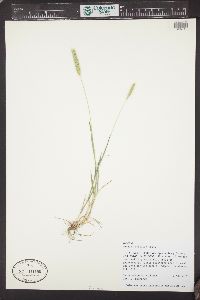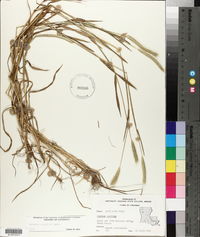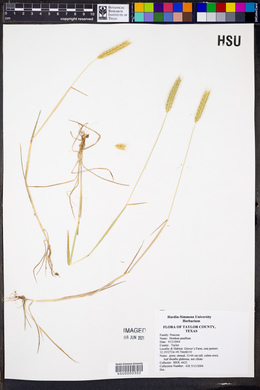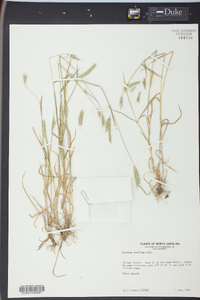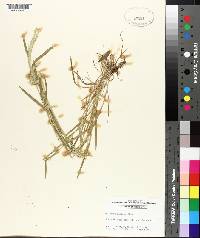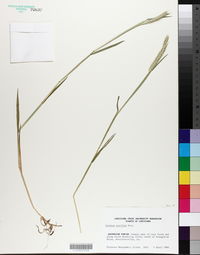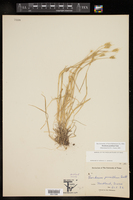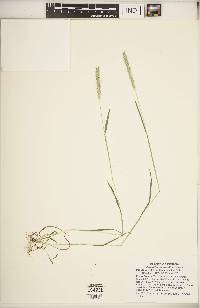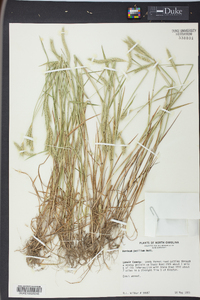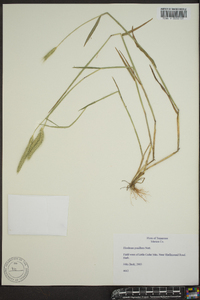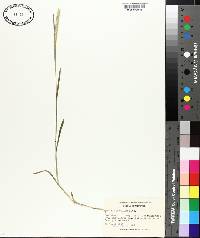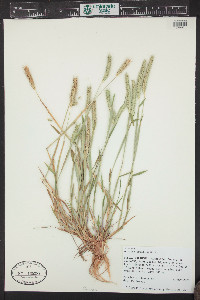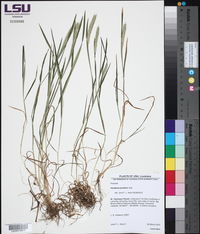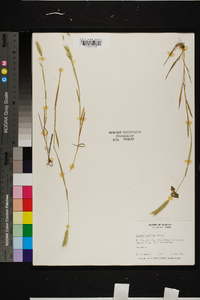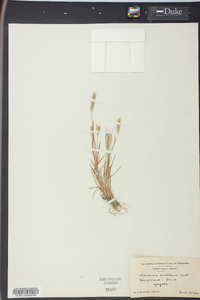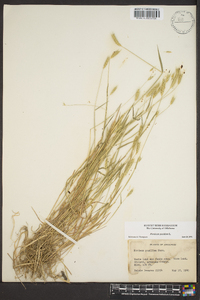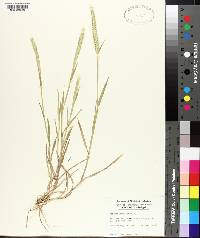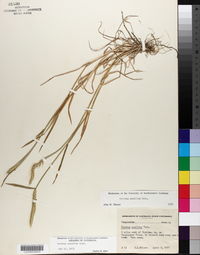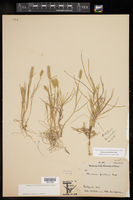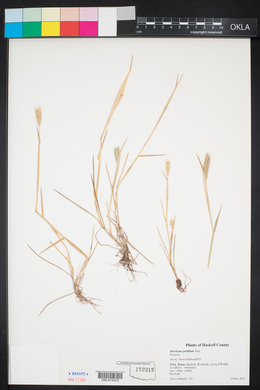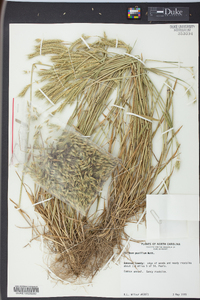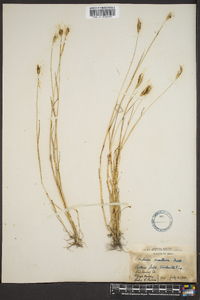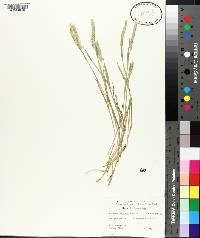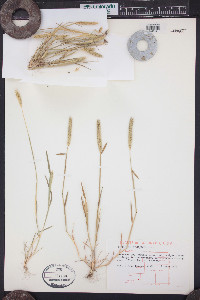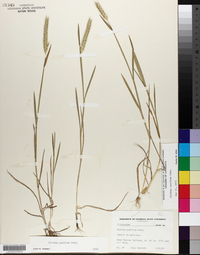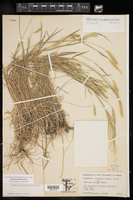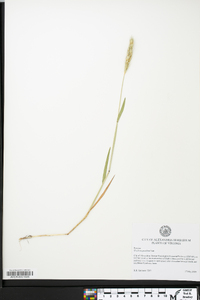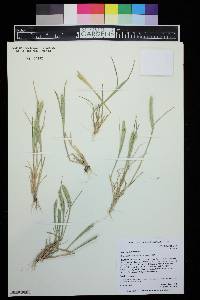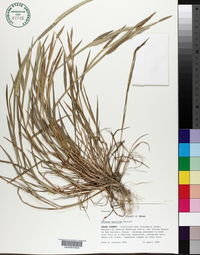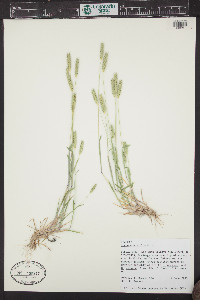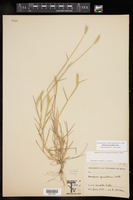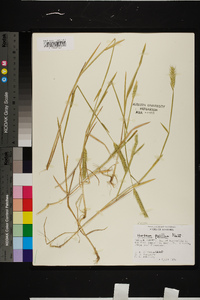
|
|
|
|
Family: Poaceae
Little Barley, more...little wildbarley
[Critesion pusillum (Nutt.) A. Löve, moreHordeum pusillum var. pubens A.S. Hitchc., Hordeum pusillum var. pusillum Nutt., Hordeum pusillum var. typicum Hauman, Hordeum riehlii] |
Plants annual; loosely tufted. Culms 10-60 cm, erect, geniculate, or ascending; nodes glabrous. Sheaths glabrous or slightly pubescent; ligules 0.2-0.8 mm; auricles absent; blades to 10.5 cm long, to 4.5 mm wide, sparsely to densely pubescent on both sides. Spikes 2-9 cm long, 3-7 mm wide, erect, often partially enclosed at maturity, pale green. Glumes straight, not divergent at maturity. Central spikelets: glumes 8-17 mm long, 0.5-1.5 mm wide, distinctly flattened near the base; lemmas 5-8.5 mm, usually glabrous, sometimes sparsely to densely pubescent, awned, awns 3.5-9.5 mm; anthers 0.7-1.8 mm. Lateral spikelets usually sterile; glumes to 18 mm; lower glumes distinctly flattened, more or less winged basally; lemmas 2.5-5.7 mm, usually awned, awns to 1.8 mm, rarely unawned; anthers 0.6-1.2 mm. 2n = 14. Hordeum pusillum grows in open grasslands, pastures, and the borders of marshes, and in disturbed places such as roadsides and waste places, often in alkaline soil. It is native, widespread, and often common in much of the Flora region. Its range extends into northern Mexico, but it is not common there. Dr. David Bogler, USDA NRCS PLANTS Database Annuals, Terrestrial, not aquatic, Stems nodes swollen or brittle, Stems erect or ascending, Stems caespitose, tufted, or clustered, Stems terete, round in cross section, or polygonal, Stem internodes hollow, Stems with inflorescence less than 1 m tall, Stems, culms, or scapes exceeding basal leaves, Leaves mostly cauline, Leaves conspicuously 2-ranked, distichous, Leaves sheathing at base, Leaf sheath mostly open, or loose, Leaf sheath smooth, glabrous, Leaf sheath hairy, hispid or prickly, Leaf sheath and blade differentiated, Leaf sheath enlarged, inflated or distended, Leaf blades linear, Leaf blades 2-10 mm wide, Leaf blades mostly flat, Leaf blades mostly glabrous, Leaf blades more or less hairy, Ligule present, Ligule an unfringed eciliate membrane, Inflorescence terminal, Inflorescence solitary, with 1 spike, fascicle, glomerule, head, or cluster per stem or culm, Inflorescence single raceme, fascicle or spike, Inflorescence spikelets arranged in a terminal bilateral spike, Flowers bisexual, Spikelets sessile or subsessile, Spikelets dorsally compressed or terete, Spikelet less than 3 mm wide, Spikelets with 1 fertile floret, Spikelets 3 per node, Spikelets distichously arranged, Spikelets bisexual, Inflorescence disarticulating between nodes or joints of rachis, rachis fragmenting, Spikelets disarticulating below the glumes, Spikelets falling with parts of disarticulating rachis or pedicel, Spikelets closely appressed or embedded in concave portions of axis, Rachilla or pedicel glabrous, Glumes present, empty bracts, Glumes 2 clearly present, Glumes equal or subequal, Glumes equal to or longer than adjacent lemma, Glumes curved, bowed or swollen outward at base, Glumes awn-like, elongated or subulate, Glumes awned, awn 1-5 mm or longer, Glumes 1 nerved, Glumes 3 nerved, Lemma coriaceous, firmer or thicker in texture than the glumes, Lemma 5-7 nerved, Lemma glabrous, Lemma apex acute or acuminate, Lemma mucronate, very shortly beaked or awned, less than 1-2 mm, Lemma distinctly awned, more than 2-3 mm, Lemma with 1 awn, Lemma awn less than 1 cm long, Lemma awned from tip, Lemma awn from sinus of bifid apex, Lemma awns straight or curved to base, Lemma margins thin, lying flat, Lemma straight, Palea present, well developed, Palea membranous, hyaline, Palea about equal to lemma, Palea 2 nerved or 2 keeled, Stamens 3, Styles 2-fid, deeply 2-branched, Stigmas 2, Fruit - caryopsis, Caryopsis ellipsoid, longitudinally grooved, hilum long-linear, Caryopsi FNA 2003, Gould 1980 Common Name: little barley Duration: Annual Nativity: Native Lifeform: Graminoid General: Loosely tufted annual grass with erect stems mostly 15-40 cm tall. Vegetative: Blades 2-5 mm wide, 2-10 cm long, flat to u-shaped, scabrous; sheath open, glabrous to short pubescent, with or without small auricles; ligule membranous, truncate, almost entire, less than 0.5 mm long. Inflorescence: Dense spicate raceme, 4-8 cm long, with 3 spikelets per node; outer glumes of the lateral spikelets awnlike, without expanded bodies; other glumes broadened and flattened above the base, scabrous, with awns 7-12 mm long; florets of lateral spikelets irregularly reduced, usually pediceled above the glumes, about half to one-third as large as fertile floret of the central spikelet; lemma of central floret 4-6 mm long with an awn 2-7 mm long. Ecology: Found on roadsides and disturbed soils below 6,000 ft (1829 m); flowers May-August. Distribution: Throughout the US; BC and AB in w. CAN; and n. MEX. Notes: The most widespread native in the genus; a compact, upright annual with blunt spikelets. Awns are shorter than the awns of other Hordeums (12 mm or less). H. brachyantherum has similarly short awns, but that species is a large perennial up to 1 m tall. Ethnobotany: Archeological evidence shows this species was cultivated by multiple tribes in North America thousands of years ago. Etymology: Hordeum is the Latin name for barley; pusillum means small, weak, or insignificant. Synonyms: Critesion pusillum, H. pusillum var. pubens Editor: SBuckley 2010, AHazelton 2015 Annual to 4(-6) dm; lvs flat, 2-4 mm wide, erect, without auricles; spikes 2-7 cm (excl. awns), erect; central spikelet sessile, the lateral on curved pedicels 0.3-0.7(-1) mm, their florets reduced, awn-tipped, and borne on curved rachilla-joints ca 0.5 mm; glumes 7-12(-15) mm, those of the central spikelet and the inner glumes of the lateral spikelets slightly to conspicuously broadened above the base before narrowing into slender awns, the outermost glumes wholly awn-like and somewhat shorter, scabrous to puberulent; fertile lemma 5-7 mm, scabrous, faintly 5-veined, tapering into a short awn (4-)5-8 mm; anthers 0.5-0.8 mm; 2n=14. Native weed of pastures, roadsides, and moderately moist waste places; Del. to Fla., w. to Wash., Calif., and n. Mex., and casually intr. n. to Me., Mich., and Minn.; s. S. Amer. Gleason, Henry A. & Cronquist, Arthur J. 1991. Manual of vascular plants of northeastern United States and adjacent Canada. lxxv + 910 pp. ©The New York Botanical Garden. All rights reserved. Used by permission. From Flora of Indiana (1940) by Charles C. Deam This species is found usually in slightly acid soils in waste places and fallow fields and along railroads and roadsides. It is infrequent to local in the southern counties and has been found in four of our northern counties in waste places and along railroads. I think that this species has been introduced into the state and I am so recording it. Spillman found it in Knox County in 1890, and, although Schneck reported a wild barley earlier, there is no specimen to verify the report. Our early authors, Baird & Taylor, Barnes, Clapp, J. M. Coulter, and Young, who collected intensively in some of the Ohio River counties, did not report a wild barley of any kind. This evidence, in addition to its habitats, convinces me that it has invaded the state since that time. ...... Indiana Coefficient of Conservatism: C = 0 Wetland Indicator Status: FAC |
|
|
|

